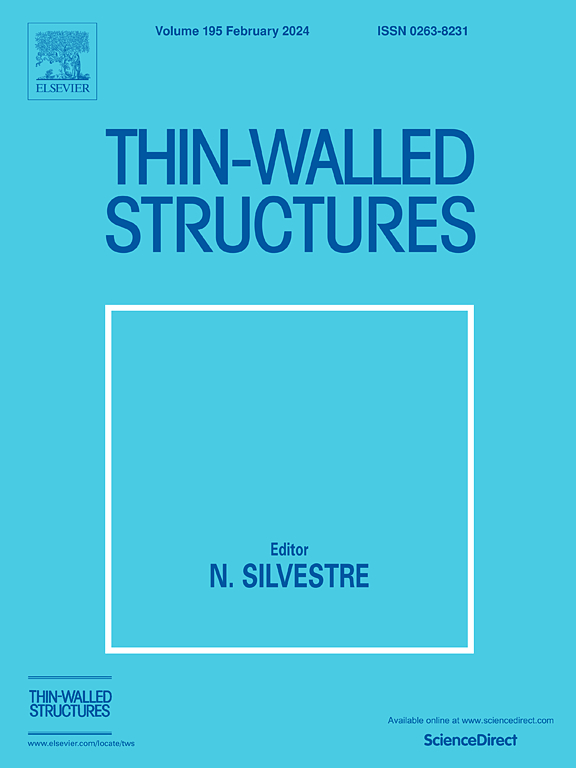Shear performance prediction for corrugated steel web girders based on machine-learning algorithms
IF 5.7
1区 工程技术
Q1 ENGINEERING, CIVIL
引用次数: 0
Abstract
This study aimed to predict the shear strength of corrugated steel web girders (CSWGs) by developing a new method based on four machine-learning (ML) algorithms, namely the support vector machine, artificial neural network, random forest, and XGBoost. Based on the acquired experimental and numerical data, a database containing 552 samples was constructed to train and test the ML models. A five-fold cross-validation approach was adopted during training to prevent model overfitting. A RandomizedSearchCV was used to optimize the hyperparameters of each model. The performance of the trained models was evaluated using four performance metrics, and the results revealed that the coefficients of determination (R2) of all ML models exceeded 0.97 when used on both training and validation sets, demonstrating the excellent performance of the ML models in predicting the shear strength of CSWGs. Additionally, the implemented ML models outperformed existing design codes and empirical formulae. The XGBoost model yielded the best prediction results with an R2 of 0.999, mean absolute error of 44.98 kN, root-mean-square error of 66.67 kN, and mean absolute percentage error of 2.1 %. By using the Shapley additive explanation to derive a visual, quantitative explanation of the XGBoost model, the yield strength, web thickness, and web height were identified as the most critical factors affecting the shear strength of CSWGs, and their average absolute Shapley values accounted for approximately 91.45 % of the total value. The ML models implemented in this study provide a promising new approach for pre-designing and verifying the stability of CSWGs.
基于机器学习算法的波形钢腹板梁剪切性能预测
本研究旨在通过开发一种基于四种机器学习(ML)算法(即支持向量机、人工神经网络、随机森林和 XGBoost)的新方法来预测波形钢腹板梁(CSWG)的抗剪强度。根据获得的实验和数值数据,构建了一个包含 552 个样本的数据库,用于训练和测试 ML 模型。在训练过程中采用了五倍交叉验证方法,以防止模型过拟合。使用 RandomizedSearchCV 来优化每个模型的超参数。结果显示,所有 ML 模型在训练集和验证集上的决定系数(R2)都超过了 0.97,这表明 ML 模型在预测 CSWG 的剪切强度方面表现出色。此外,已实施的 ML 模型的性能优于现有的设计规范和经验公式。XGBoost 模型的预测结果最好,R2 为 0.999,平均绝对误差为 44.98 kN,均方根误差为 66.67 kN,平均绝对百分比误差为 2.1%。通过使用 Shapley 加法解释得出 XGBoost 模型的可视化定量解释,屈服强度、腹板厚度和腹板高度被确定为影响 CSWG 剪切强度的最关键因素,其平均绝对 Shapley 值约占总值的 91.45%。本研究采用的 ML 模型为预先设计和验证 CSWG 的稳定性提供了一种很有前途的新方法。
本文章由计算机程序翻译,如有差异,请以英文原文为准。
求助全文
约1分钟内获得全文
求助全文
来源期刊

Thin-Walled Structures
工程技术-工程:土木
CiteScore
9.60
自引率
20.30%
发文量
801
审稿时长
66 days
期刊介绍:
Thin-walled structures comprises an important and growing proportion of engineering construction with areas of application becoming increasingly diverse, ranging from aircraft, bridges, ships and oil rigs to storage vessels, industrial buildings and warehouses.
Many factors, including cost and weight economy, new materials and processes and the growth of powerful methods of analysis have contributed to this growth, and led to the need for a journal which concentrates specifically on structures in which problems arise due to the thinness of the walls. This field includes cold– formed sections, plate and shell structures, reinforced plastics structures and aluminium structures, and is of importance in many branches of engineering.
The primary criterion for consideration of papers in Thin–Walled Structures is that they must be concerned with thin–walled structures or the basic problems inherent in thin–walled structures. Provided this criterion is satisfied no restriction is placed on the type of construction, material or field of application. Papers on theory, experiment, design, etc., are published and it is expected that many papers will contain aspects of all three.
 求助内容:
求助内容: 应助结果提醒方式:
应助结果提醒方式:


